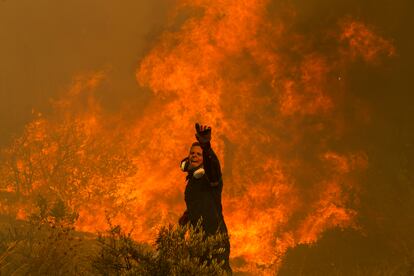The world feeds the climate crisis with public money: Fossil fuel subsidies amounted to $7 trillion in 2022
An analysis by the IMF warns that government financial aid for polluting energy sources continues to grow, and calls for its complete elimination


Fossil-fuel subsidies in 2022 added up to $7 trillion, the equivalent of 7.1% of global gross domestic product, according to a report prepared by analysts from the International Monetary Fund (IMF). The report, released this Thursday, calls for a complete elimination of these subsidies. Coal, oil and natural gas, which benefit from these enormous amounts of money, are the main causes of a climate change that fuels problems such as the extreme heat and the great fires that are affecting a large part of the Northern Hemisphere this summer. Paradoxically, the enormous dependence that humanity has on these fuels that take things to such extremes is largely supported by public funds.
When these fuels are burned to generate power, they release the greenhouse gases that overheat the planet. Ending direct and indirect aid to redirect it to cleaner ways of producing energy has been one of the main demands of climate change activists for years, as well as being one of the most important actions to fight global warming that are being discussed in the UN. In the final declaration of the Glasgow climate summit, held at the end of 2021, an explicit call was made to gradually eliminate this public aid to fossil fuels. However, it continues to rise, as the IMF analysis warns.
The IMF experts take into account explicit subsidies (what the producers and consumers of these fuels receive) and implicit subsidies (related to the indirect environmental and health costs, as well as the tax revenue that the state stops receiving after the deductions). It is considering these two variables that the IMF obtained the amount of $7 trillion for 2022. Explicit subsidies represent 18% of the total, while implicit ones accumulate 82%. This last part includes external factors, such as the cost that the damage that pollution causes to the health of citizens entails for an economy.
As a solution to the senselessness of fueling the climate crisis with public money, the IMF analysts suggest removing explicit subsidies to make fuel prices increase, which “would lead firms and households to consider environmental costs when making consumption and investment decisions. The result would be cutting global carbon-dioxide emissions significantly.” In addition, they call for “corrective taxes,” such as a tax on carbon dioxide, which could reduce emissions of this greenhouse gas (the main one) by 34% compared to 2019 levels in 2030. This would be in line with keeping global warming within the limits set by the Paris Agreement.
The previous analysis of these subsidies, carried out by the IMF two years ago, estimated the aid in 2020 at $6 trillion. “Fossil-fuel subsidies rose by $2 trillion over the past two years as explicit subsidies (undercharging for supply costs) more than doubled to $1.3 trillion,” states the study. The analysts explain that much of the increase is due to temporary price support measures related to the energy crisis caused by Russia’s invasion of Ukraine.
However, the big problem is the implicit aid, which accounts for more than 80% of the total and which the IMF expects to continue to increase as the consumption of fossil fuels grows in developing countries, “which tend to have higher-polluting power plants, factories, and vehicles, along with dense populations living and working close to these pollution sources.” These subsidies mean that governments are giving up a valuable source of much-needed revenue and undermining poverty reduction goals, “as fuel subsidies benefit rich households more than poor ones,” warns the report.
By region, East Asia and the Pacific account for almost half of the world’s subsidies. If the analysis is focused by country and in absolute terms, China continues to be the largest subsidizer of fossil fuels, followed by the United States, Russia, the EU and India, reports the IMF. These are, too, the world’s largest emitters of greenhouse gases.
Sign up for our weekly newsletter to get more English-language news coverage from EL PAÍS USA Edition
Tu suscripción se está usando en otro dispositivo
¿Quieres añadir otro usuario a tu suscripción?
Si continúas leyendo en este dispositivo, no se podrá leer en el otro.
FlechaTu suscripción se está usando en otro dispositivo y solo puedes acceder a EL PAÍS desde un dispositivo a la vez.
Si quieres compartir tu cuenta, cambia tu suscripción a la modalidad Premium, así podrás añadir otro usuario. Cada uno accederá con su propia cuenta de email, lo que os permitirá personalizar vuestra experiencia en EL PAÍS.
¿Tienes una suscripción de empresa? Accede aquí para contratar más cuentas.
En el caso de no saber quién está usando tu cuenta, te recomendamos cambiar tu contraseña aquí.
Si decides continuar compartiendo tu cuenta, este mensaje se mostrará en tu dispositivo y en el de la otra persona que está usando tu cuenta de forma indefinida, afectando a tu experiencia de lectura. Puedes consultar aquí los términos y condiciones de la suscripción digital.
More information
Extreme heat: A chronicle of the hottest days on the planet
Últimas noticias
Most viewed
- Sinaloa Cartel war is taking its toll on Los Chapitos
- Oona Chaplin: ‘I told James Cameron that I was living in a treehouse and starting a permaculture project with a friend’
- Reinhard Genzel, Nobel laureate in physics: ‘One-minute videos will never give you the truth’
- Why the price of coffee has skyrocketed: from Brazilian plantations to specialty coffee houses
- Silver prices are going crazy: This is what’s fueling the rally









































